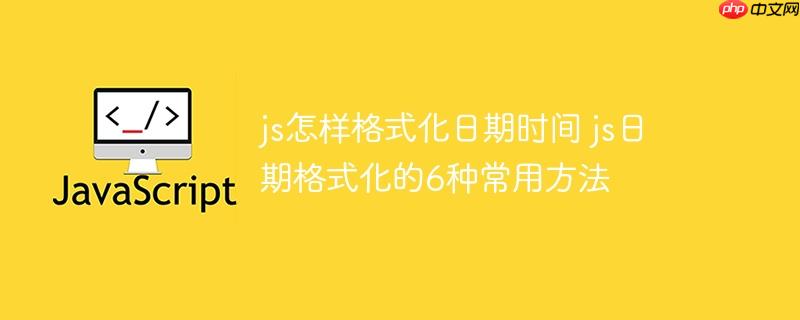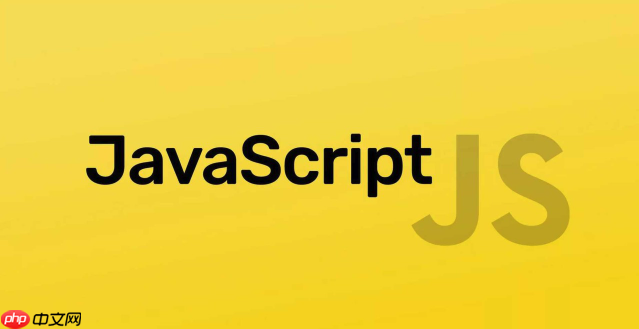在javascript中格式化日期时间,可以通过多种方法实现。1. 使用tolocale...系列方法:简单快捷但不够灵活,适用于本地化格式输出;2. 手动拼接字符串:完全可控但代码冗长,适合需要精确格式的场景;3. 使用intl.datetimeformat:灵活且性能好,适合需要高定制化的本地化格式;4. 使用day.js:api简洁、功能强大,但需引入第三方库;5. 使用date-fns:模块化程度高,可按需引入,适合对代码体积敏感的场景;6. 自定义扩展date对象:使用方便但可能造成原型污染,需谨慎使用。处理时区问题的方法包括:1. 使用date对象的utc方法:确保获取utc时间但需手动转换;2. 使用intl.datetimeformat的timezone选项:可指定目标时区但需知道时区名称;3. 使用day.js的timezone插件:方便强大但需引入插件;4. 使用date-fns-tz:与date-fns一致的设计风格,支持按需引入函数。选择合适的方法取决于具体需求,如简单场景可选tolocale...或intl.datetimeformat,复杂场景可用day.js或date-fns,性能敏感则推荐intl.datetimeformat或手动拼接,代码体积敏感可考虑date-fns或手动拼接。

通常,在JavaScript中格式化日期时间,可以使用内置的Date对象结合一些方法,或者借助第三方库如Moment.js(现在推荐使用Day.js替代,体积更小)或date-fns。 下面将介绍几种常用的方法。

解决方案

使用toLocale...系列方法: 这是最简单的方法,利用Date对象提供的本地化字符串转换功能。

const date = new Date();
console.log(date.toLocaleDateString()); // 输出:2024/10/27 (取决于你的本地设置)
console.log(date.toLocaleTimeString()); // 输出:15:30:45 (取决于你的本地设置)
console.log(date.toLocaleString()); // 输出:2024/10/27 15:30:45 (取决于你的本地设置)
// 也可以指定locale和options
console.log(date.toLocaleDateString('zh-CN', { year: 'numeric', month: 'long', day: 'numeric' })); // 输出:2024年10月27日这种方式的优点是简单快捷,缺点是格式受到用户本地设置的影响,不够灵活。 比如,有时你希望日期是YYYY-MM-DD格式,用这个方法可能就比较困难。
手动拼接字符串: 这是最灵活的方法,可以完全自定义格式。
const date = new Date();
const year = date.getFullYear();
const month = String(date.getMonth() + 1).padStart(2, '0'); // 月份从0开始,需要+1,并且补零
const day = String(date.getDate()).padStart(2, '0');
const hours = String(date.getHours()).padStart(2, '0');
const minutes = String(date.getMinutes()).padStart(2, '0');
const seconds = String(date.getSeconds()).padStart(2, '0');
const formattedDate = `${year}-${month}-${day} ${hours}:${minutes}:${seconds}`;
console.log(formattedDate); // 输出:2024-10-27 15:30:45这种方式的优点是完全可控,缺点是代码比较冗长,容易出错。 而且,处理时区问题会比较麻烦。
使用Intl.DateTimeFormat: 这是ES2015引入的API,提供了更强大的本地化日期时间格式化功能。
const date = new Date();
const formatter = new Intl.DateTimeFormat('zh-CN', {
year: 'numeric',
month: '2-digit',
day: '2-digit',
hour: '2-digit',
minute: '2-digit',
second: '2-digit',
hour12: false // 24小时制
});
console.log(formatter.format(date)); // 输出:2024/10/27 15:30:45Intl.DateTimeFormat比toLocale...系列方法更灵活,可以更精确地控制格式,而且性能更好。 但是,API相对复杂一些。
使用Day.js: Day.js是一个轻量级的日期时间处理库,API设计与Moment.js类似,但体积更小。
// 首先需要安装Day.js: npm install dayjs
import dayjs from 'dayjs'
const date = new Date();
console.log(dayjs(date).format('YYYY-MM-DD HH:mm:ss')); // 输出:2024-10-27 15:30:45Day.js的优点是API简洁易用,功能强大,体积小巧。 缺点是需要引入第三方库。
使用date-fns: date-fns是另一个流行的日期时间处理库,它采用函数式编程风格,每个函数都是独立的,可以按需引入,避免引入不必要的代码。
// 首先需要安装date-fns: npm install date-fns
import { format } from 'date-fns'
import { zhCN } from 'date-fns/locale' // 引入中文locale
const date = new Date();
console.log(format(date, 'yyyy-MM-dd HH:mm:ss', { locale: zhCN })); // 输出:2024-10-27 15:30:45date-fns的优点是模块化程度高,可以按需引入,避免代码冗余。 缺点是API相对复杂一些。
自定义扩展Date对象: 可以为Date对象添加自定义的format方法。
Date.prototype.format = function(fmt) {
const o = {
'Y+': this.getFullYear(), // 年份
'M+': this.getMonth() + 1, // 月份
'D+': this.getDate(), // 日
'H+': this.getHours(), // 小时
'm+': this.getMinutes(), // 分钟
's+': this.getSeconds(), // 秒
'q+': Math.floor((this.getMonth() + 3) / 3), // 季度
'S': this.getMilliseconds() // 毫秒
};
if (/(Y+)/.test(fmt)) {
fmt = fmt.replace(RegExp.$1, (this.getFullYear() + '').substr(4 - RegExp.$1.length));
}
for (let k in o) {
if (new RegExp('(' + k + ')').test(fmt)) {
fmt = fmt.replace(RegExp.$1, (RegExp.$1.length == 1) ? (o[k]) : (('00' + o[k]).substr(('' + o[k]).length)));
}
}
return fmt;
}
const date = new Date();
console.log(date.format('YYYY-MM-DD HH:mm:ss')); // 输出:2024-10-27 15:30:45这种方式的优点是使用方便,缺点是会污染Date对象原型,可能与其他代码冲突。 需要谨慎使用。
js格式化日期时间时,如何处理时区问题?
处理时区问题是一个复杂的话题,因为涉及到用户的地理位置、夏令时等因素。 以下是一些常用的方法:
使用Date对象的UTC方法: Date对象提供了一系列UTC方法,可以获取UTC时间。 例如,getUTCDate(), getUTCHours(), getUTCMinutes()等。 可以先将日期时间转换为UTC时间,然后再进行格式化。
const date = new Date();
const year = date.getUTCFullYear();
const month = String(date.getUTCMonth() + 1).padStart(2, '0');
const day = String(date.getUTCDate()).padStart(2, '0');
const hours = String(date.getUTCHours()).padStart(2, '0');
const minutes = String(date.getUTCMinutes()).padStart(2, '0');
const seconds = String(date.getUTCSeconds()).padStart(2, '0');
const formattedDate = `${year}-${month}-${day} ${hours}:${minutes}:${seconds} UTC`;
console.log(formattedDate);这种方法可以确保日期时间是UTC时间,但需要手动进行时区转换。
使用Intl.DateTimeFormat的timeZone选项: Intl.DateTimeFormat提供了timeZone选项,可以指定时区。
const date = new Date();
const formatter = new Intl.DateTimeFormat('en-US', {
year: 'numeric',
month: '2-digit',
day: '2-digit',
hour: '2-digit',
minute: '2-digit',
second: '2-digit',
timeZone: 'America/Los_Angeles' // 指定时区为美国洛杉矶
});
console.log(formatter.format(date));这种方法可以方便地将日期时间转换为指定的时区,但需要知道目标时区的名称。
使用Day.js的timezone插件: Day.js提供了一个timezone插件,可以方便地进行时区转换。
// 首先需要安装Day.js和timezone插件: npm install dayjs @types/dayjs timezone
import dayjs from 'dayjs'
import utc from 'dayjs/plugin/utc'
import timezone from 'dayjs/plugin/timezone' // 导入timezone插件
dayjs.extend(utc)
dayjs.extend(timezone)
const date = new Date();
console.log(dayjs(date).tz('America/Los_Angeles').format('YYYY-MM-DD HH:mm:ss')); // 转换为美国洛杉矶时区这种方法使用方便,功能强大,但需要引入第三方库和插件。
使用date-fns-tz: date-fns本身不直接支持时区,但有一个单独的库date-fns-tz可以用来处理时区。
// 首先需要安装date-fns和date-fns-tz: npm install date-fns date-fns-tz
import { format } from 'date-fns'
import { utcToZonedTime, formatInTimeZone } from 'date-fns-tz'
const date = new Date();
const timeZone = 'America/Los_Angeles'
const zonedDate = utcToZonedTime(date, timeZone)
console.log(formatInTimeZone(zonedDate, timeZone, 'yyyy-MM-dd HH:mm:ss'))这个库与date-fns的设计理念一致,按需引入函数,避免不必要的代码。
如何选择合适的日期时间格式化方法?
选择合适的日期时间格式化方法取决于你的具体需求。
简单场景: 如果只是简单地格式化日期时间,不需要太多的自定义,可以使用toLocale...系列方法或Intl.DateTimeFormat。
复杂场景: 如果需要完全自定义格式,或者需要处理时区问题,可以使用Day.js或date-fns。
性能敏感场景: 如果对性能要求比较高,可以使用Intl.DateTimeFormat,或者手动拼接字符串。 避免在循环中频繁创建Day.js或date-fns对象。
代码体积敏感场景: 如果对代码体积要求比较高,可以使用date-fns,并按需引入函数。 或者,手动拼接字符串。
另外,还需要考虑浏览器的兼容性。 toLocale...系列方法和Intl.DateTimeFormat是ES5和ES2015引入的API,兼容性较好。 Day.js和date-fns需要引入第三方库,但可以提供更好的兼容性。
除了上述方法,还有一些其他的日期时间处理库,例如Luxon、js-joda等。 可以根据自己的喜好和需求选择合适的库。
以上就是js怎样格式化日期时间 js日期格式化的6种常用方法的详细内容,更多请关注php中文网其它相关文章!

每个人都需要一台速度更快、更稳定的 PC。随着时间的推移,垃圾文件、旧注册表数据和不必要的后台进程会占用资源并降低性能。幸运的是,许多工具可以让 Windows 保持平稳运行。

Copyright 2014-2025 https://www.php.cn/ All Rights Reserved | php.cn | 湘ICP备2023035733号